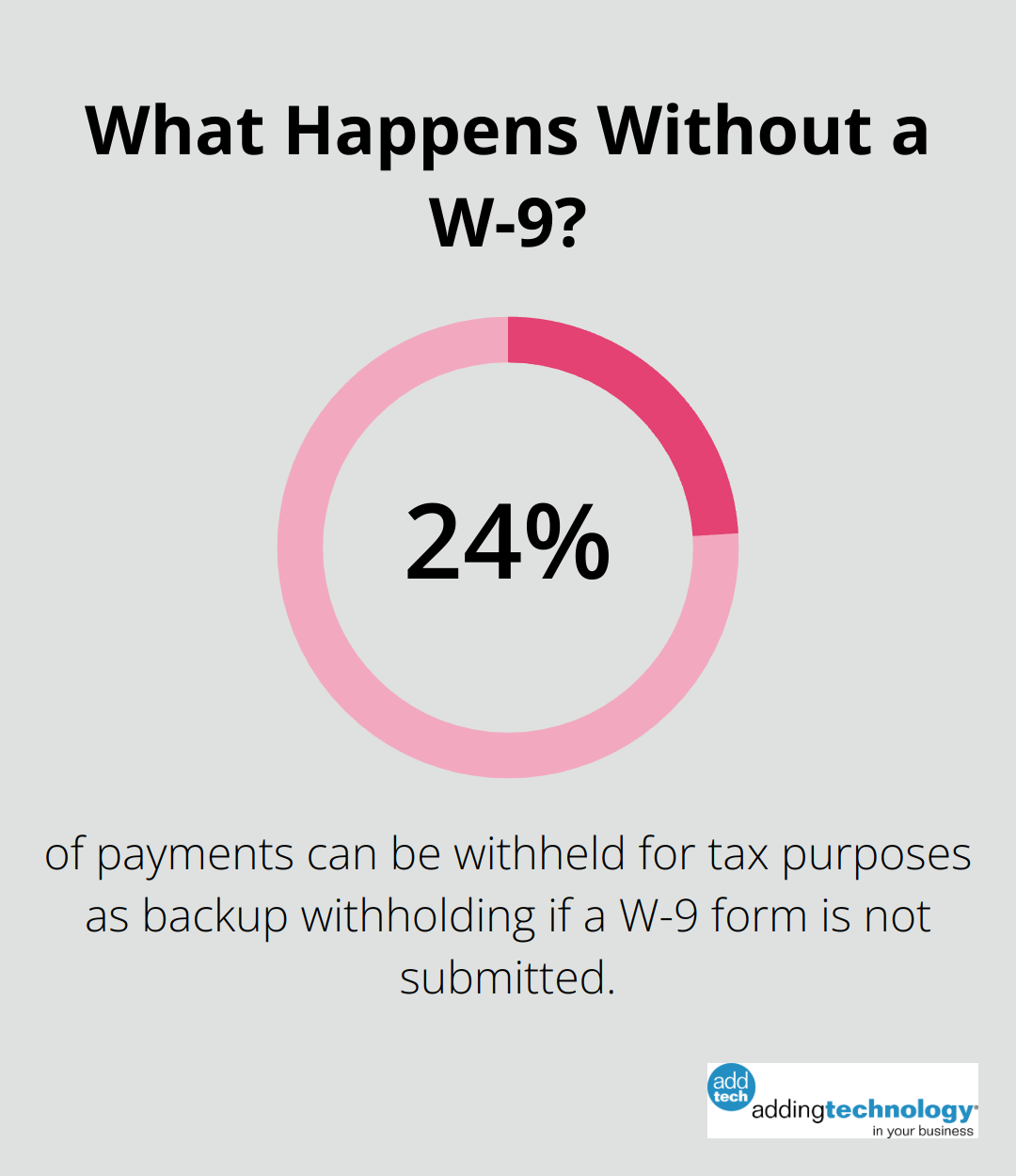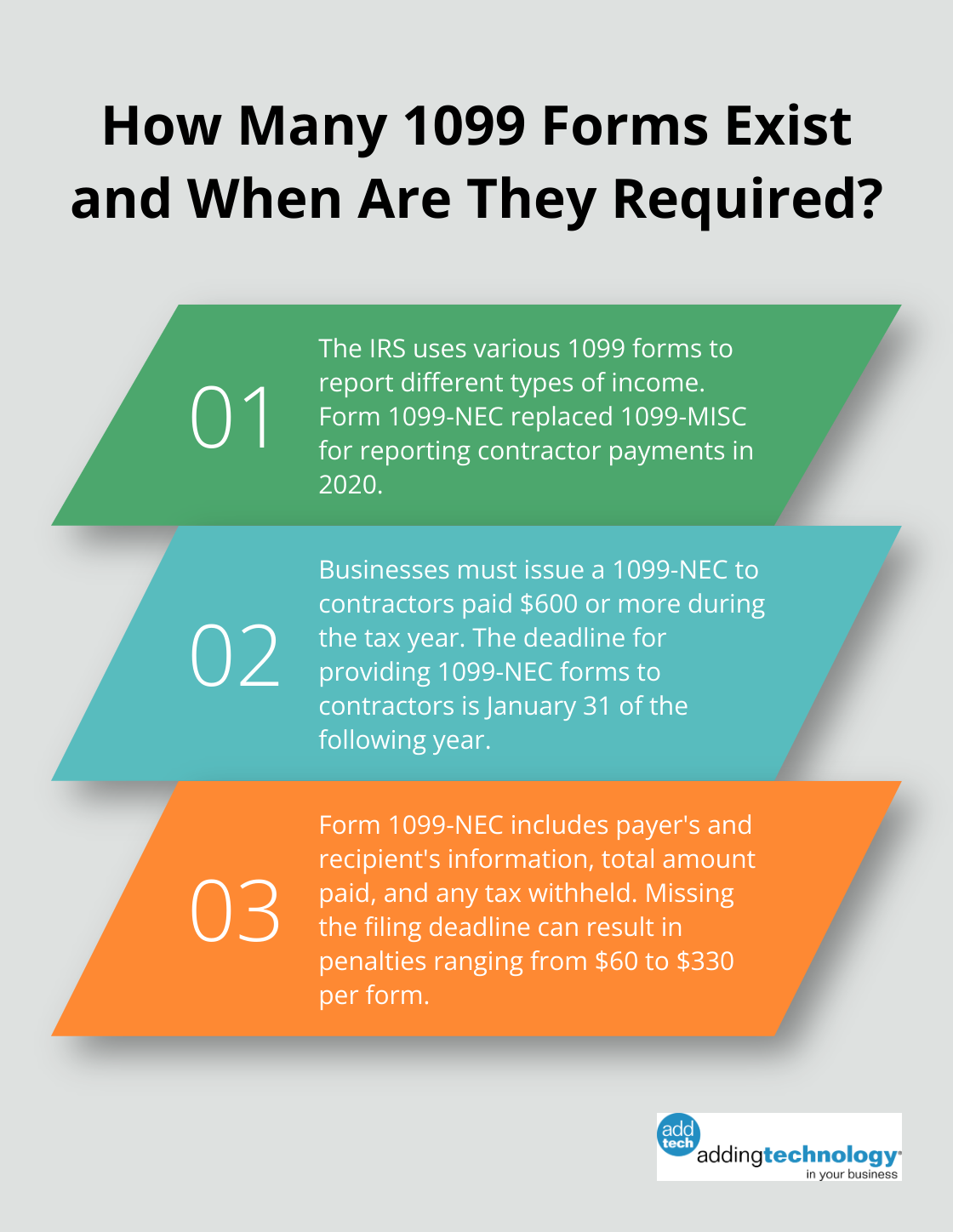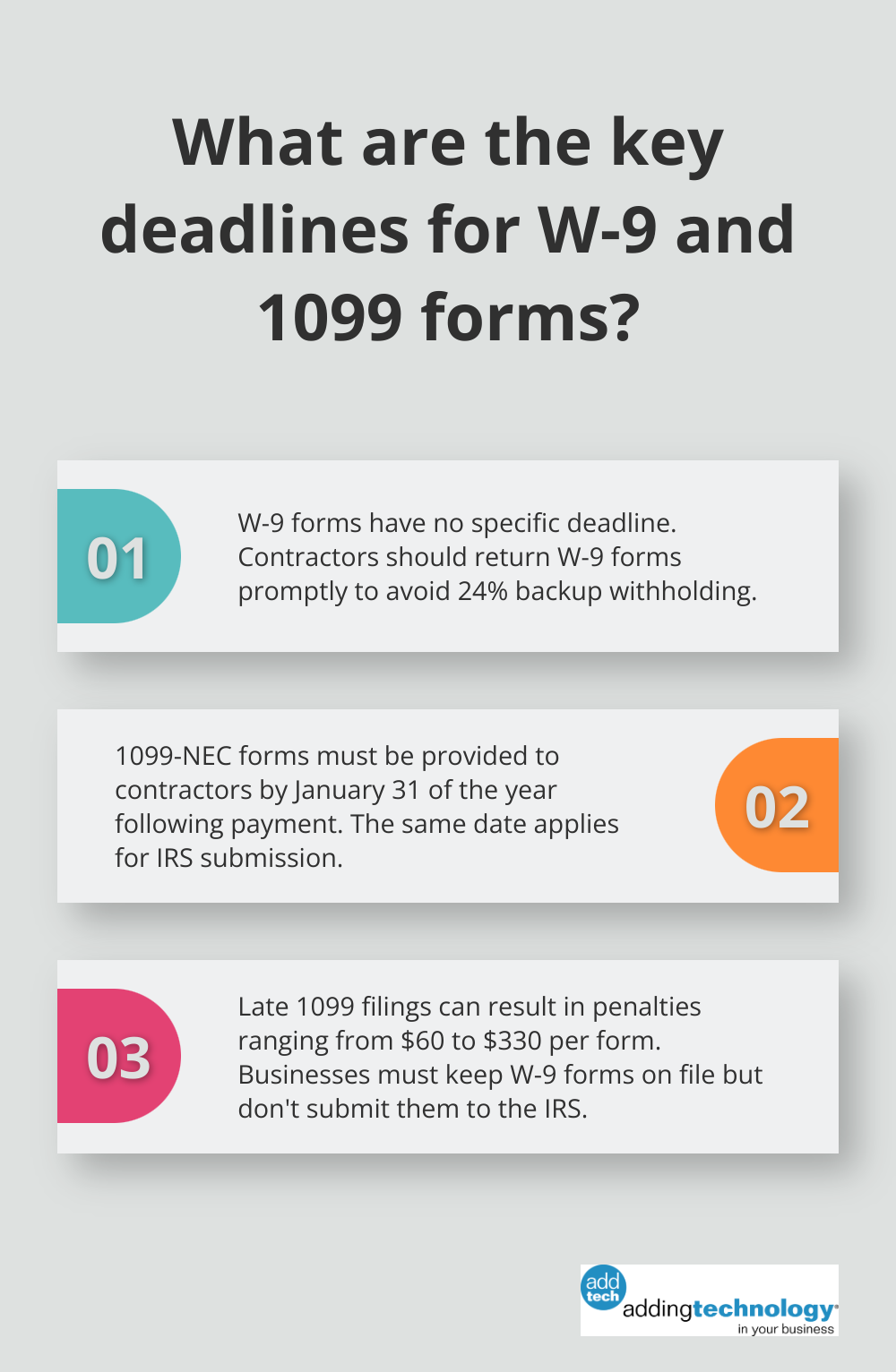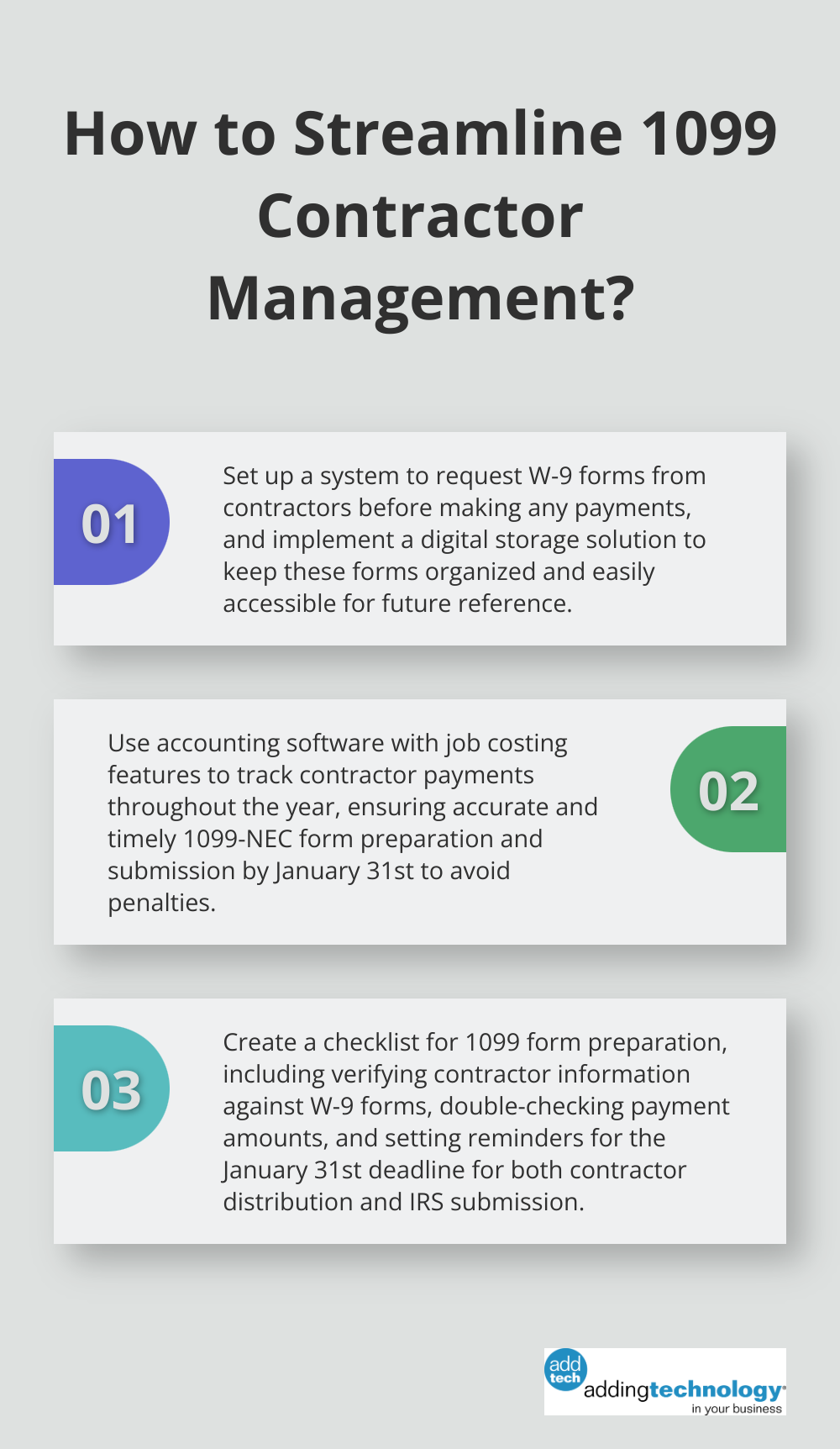
At adding technology, we often encounter questions about the differences between W-9 forms and 1099 forms. These two documents play crucial roles in tax reporting for businesses and independent contractors.
Understanding when to use a W-9 form vs 1099 can help you navigate tax obligations more effectively. In this post, we’ll break down the key aspects of each form and provide guidance on choosing the right one for your situation.
The W-9 form, officially titled “Request for Taxpayer Identification Number and Certification,” serves as a vital document in business and tax reporting. This form allows businesses to collect essential tax information from independent contractors, freelancers, and vendors. It forms the basis for accurate tax reporting and helps prevent potential issues with the IRS.
Individuals or entities providing services to a business as independent contractors should expect to fill out a W-9 form. This includes freelancers, consultants, and even landlords receiving rent payments. A 2023 Upwork study revealed that 64 million Americans freelanced this year, underscoring the widespread relevance of the W-9 form in today’s gig economy.
When completing a W-9, you must provide several key pieces of information:

It’s important to use your legal name rather than a nickname or business name to avoid discrepancies with IRS records. Using an incorrect name or TIN (a common mistake) can lead to processing delays.
Unlike many tax forms, the W-9 doesn’t have a set submission deadline. However, prompt completion and return of the form when requested by a client is in your best interest. Failure to do so can result in backup withholding, where the payer must withhold 24% of your payments for tax purposes.
For businesses, requesting W-9 forms from contractors before making any payments is a wise practice. This proactive approach ensures you have the necessary information for year-end tax reporting and helps avoid last-minute rushes or potential penalties.
The W-9 form remains on file with the business requesting it and is not submitted to the IRS. Its information serves to generate 1099 forms, which we’ll explore in the next section of this post. Understanding the intricacies of the W-9 form sets the stage for a deeper dive into the world of 1099 forms and their specific requirements.
The IRS uses various 1099 forms to report different types of income. Form 1099-NEC (Nonemployee Compensation) is the most common for contractors, replacing the 1099-MISC for reporting contractor payments in 2020. This form is used by businesses to report payments made to non-employees, including freelancers, independent contractors, and sole proprietors who provided services. Other forms include 1099-INT for interest income and 1099-DIV for dividends.
Businesses must issue a 1099-NEC to any contractor paid $600 or more during the tax year. If you use Form 1099-NEC to report sales totaling $5,000 or more, then you are required to file Form 1099-NEC with the IRS by January 31.

The deadline for providing 1099-NEC forms to contractors is January 31 of the year following the payments. Missing this deadline can result in penalties (ranging from $60 to $330 per form, depending on how late they’re filed).
A 1099-NEC form includes several key pieces of information:
It’s important to ensure this information matches what’s on the contractor’s W-9 form. Discrepancies can lead to processing delays and potential IRS inquiries.
For construction businesses, accurate 1099 reporting is particularly important. The industry’s frequent use of subcontractors means a higher volume of 1099 forms to manage. Proper tracking of payments throughout the year can significantly streamline this process.
Modern accounting software and services can help construction companies maintain precise records, ensuring timely and accurate 1099 filings. Features like real-time job costing allow businesses to track contractor payments as they occur, making year-end reporting much simpler.
The next section will explore the key differences between W-9 and 1099 forms, providing you with a clear understanding of how these essential tax documents interact and complement each other in the financial reporting process.
W-9 forms don’t have a specific deadline. Businesses request these forms from contractors before making payments. Contractors should return W-9 forms promptly to avoid backup withholding (currently at 24%). Businesses keep W-9 forms on file but don’t submit them to the IRS.
1099 forms have strict deadlines. For 1099-NEC (which reports nonemployee compensation), businesses must provide the form to contractors by January 31 of the year following payment. The same date applies for IRS submission. Late filings can result in penalties ($60 to $330 per form, depending on lateness).
Contractors fill out W-9 forms. They must ensure the information is accurate and current. Businesses prepare and submit 1099 forms based on the information provided in the W-9 and the payments made to the contractor.

This distinction affects accountability. Contractors must provide correct W-9 information, while businesses must accurately transfer this data to the 1099 and report payments correctly.
W-9 forms don’t directly impact contractor taxes, but the information they contain generates 1099 forms, which do affect tax reporting. Contractors must include all income reported on 1099 forms in their tax returns, even if they receive multiple 1099s from different clients.
Businesses use W-9 information to complete 1099s, which they then use to report payments to the IRS. This reporting helps the IRS track income and ensure proper tax collection. Businesses that fail to issue required 1099s may face penalties. Contractors who don’t report all their 1099 income risk audits and additional tax liabilities.
In the construction industry, accurate 1099 reporting is particularly important due to the frequent use of subcontractors. Construction companies often deal with a higher volume of 1099 forms, making proper payment tracking throughout the year essential for streamlined year-end reporting.
Modern accounting software can help businesses maintain precise records, ensuring timely and accurate 1099 filings. Features like job costing allow companies to track contractor payments as they occur, simplifying year-end reporting. Some solutions offer seamless construction invoicing and customizable reports tailored specifically for the construction industry, helping businesses streamline their financial processes and maintain compliance.
The W-9 form and 1099 form serve distinct purposes in tax reporting for businesses and contractors. Companies must collect W-9 forms before making payments and issue 1099 forms by specific deadlines to report those payments. Accurate record-keeping throughout the year simplifies the process of managing these forms and ensures compliance with IRS regulations.

Construction companies can benefit from implementing robust systems to track contractor payments and store W-9 information securely. This approach not only streamlines year-end reporting but also provides valuable insights into a business’s financial health. The relationship between W-9 forms and 1099 forms (often referred to as “W-9 form vs 1099”) is essential for accurate tax reporting in the construction industry.
Adding Technology offers expert accounting and financial management services tailored for the construction industry. Their solutions include real-time job costing and advanced technology integration, which allow contractors to focus on their projects while maintaining solid financial foundations. Proper management of these forms contributes to the overall financial health of construction businesses.









At adding technology, we know you want to focus on what you do best as a contractor. In order to do that, you need a proactive back office crew who has financial expertise in your industry.
The problem is that managing and understanding key financial compliance details for your business is a distraction when you want to spend your time focused on building your business (and our collective future).
We understand that there is an art to what contractors do, and financial worries can disrupt the creative process and quality of work. We know that many contractors struggle with messy books, lack of realtime financial visibility, and the stress of compliance issues. These challenges can lead to frustration, overwhelm, and fear that distracts from their core business.
That's where we come in. We're not just accountants; we're part of your crew. We renovate your books, implement cutting-edge technology, and provide you with the real-time job costing and financial insights you need to make informed decisions. Our services are designed to give you peace of mind, allowing you to focus on what you do best - creating and building.
Here’s how we do it:
Schedule a conversation today, and in the meantime, download the Contractor’s Blueprint for Financial Success: A Step by-Step Guide to Maximizing Profits in Construction.” So you can stop worrying about accounting, technology, and compliance details and be free to hammer out success in the field.